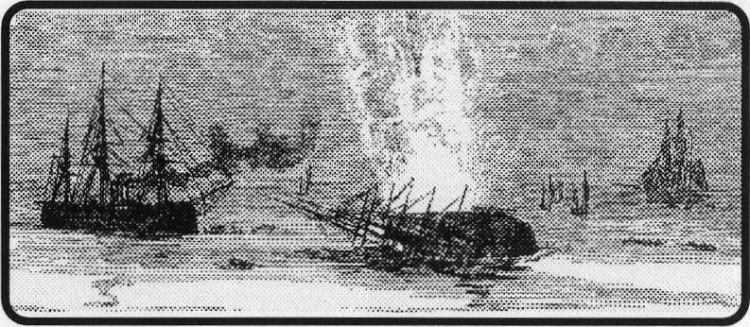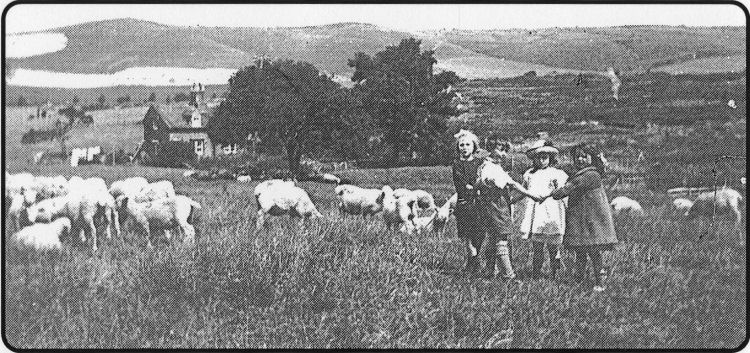
Published 28 September 2000
The Grosser Kurfurst sank so quickly that 287 German sailors were
drowned. Many were later buried in the Cheriton Road cemetery.
Survivors snatched from the sea numbered around 250.
This major disaster, which led to vital changes in seamanship in the German
Navy, was commemorated by an attractive memorial which has for years been
maintained by
Germany. In fact, until war broke out between our two nations, the
anniversary of the tragedy was marked by an annual service in Folkestone.
Alan was reminded of the incident by news in my Dover Memories page of a
video documentary being made at St Margaret’s Bay, recently by the German
national TV network Spiegel. The documentary is about
the wreck of the world’s largest sailing ship Preussen, off Dover 90 years
ago, and a local maritime historian and I were asked to help with the making
of the feature.
Alan Oram says he wonders if Spiegel know that there was another Preussen.
She was one of the German warships which were holding an exercise off
Folkestone when the other two ships collided - fortunately, in fine weather.
Local folklore has it that there was a valuable gold eagle which went down
with the Grosser Kurfurst.
Said to have been presented by the Kaiser, because the warship is thought to
have been the first of the dreadnought class of battleships, it had pride of
place in the wardroom of the vessel.
And, in 1987, Alan told me, there was a gruesome sequel to the 1878 tragedy.
A diver lost his life in a bid to recover the golden eagle. It is feared he
became
trapped by an underwater obstruction. And Alan wonders if this has anything
to do with the dumping of boiler ash from cross-Channel ferries over the two
halves of the wreck of the Grosser Kurfurst, effectively creating a tomb for
the remainder of the German seaman trapped below.
Alan says he understands the ash was dumped there following complaints by
local people about the frequency with which corpses floated to the surface
all round the coast as far afield as Dungeness Bay and which then had to be
recovered for a decent burial.
Alan Taylor, Chairman of Folkestone & District Local History
Society, is due to feature “Folkestone’s Disappearing Churches” at the AGM
of the Society in the Holy Trinity Church hall, Sandgate Road, on October 4.
The meeting is at 7.30pm.
Mike Wilson writes from Bridlington about his water colour picture of Copt
Point, Folkestone, dating from 1911 by P.W. Knowles which is of some
quality. A black and white, computer-scanned copy he sent would not
reproduce in the paper. He wonders if the artist was well known in the town.
The painting is in an autograph album which was owned by Marguerite Irene
Roberts, who once lived at 35 Radnor Park
Road, Folkestone. There are also drawings and paintings by Valerina Coulter,
Richard Francis, Ada Lukey, Sissie Francis, Phyllis Crofts and E.M.
Stringer.
One page, dated Thursday, February 13, 1913, he says, has the name of the
Osborne Hotel, Folkestone, on it. This was a “high class temperance hotel”
at 10 Bouverie Road West.
“Any information readers can give me on the above names would be
appreciated," writes Mr Wilson, who will bring the album with him when he
visits the town in October with National Holidays, staying at the hotel
Burstin. His phone/fax number is 01262 609228.
Sea drama
A READER of Memories in our sister paper, the Dover Express, Alan Oram, of
Temple Ewell, was telling me the other day of the sea drama off Folkestone,
back in 1878, when two German warships, the Grosser Kurfurst and Kaiser
Wilhelm, collided in changing course to evade a passing sailing ship.
ABOVE and left are two more pictures shown to me by Gerald Taylor, a retired
electrical fitter, now living in Hythe, who described his fireman father's
lucky wartime escape in last week's Memories. The photo above, from the
1920s shows Park Farm Cottage near Downs Road and was taken by his
grandfather. Pictured left is the "Galloping Road" -now Churchill Avenue -
and a farm cart from Snape St Leslie's Farm in Canterbury Rd.



 |
|
1900
Felix slams court ban on street‘entertainers'.
*1 Q/\/\SCANDALOUS decision - A century _L«s\JV/ago there were stories
or readers' letters about flics and rats, the disgraceful and
"unhealthy" state of the old pond at the Bayle and Felix was writing
about what he called a scandalous decision by the local court. Referring
to the town worthies as the “Great Unpaid" he said they had gone 'over
the top' in deciding to outlaw local street entertainers. 'A more
scandalous order (he called it the 'Russian edict') never proceeded from
a magisterial bunch." he declared. Local entertainment and colour was
augmented by these sometimes very talented residents, he said, but there
was a faction in the town who wanted to "keep Folkestone select." They
wanted to maintain its 'tone' and to keep away 'verminous Italians' and
'their street organs, monkeys and such ilk.' ''Whether these gentlemen
on the bcnch are qualified to act as public censors of music is a
question very much open to doubt," he said. Still, the comment about the
Baylc pond by Felix, seems to have had results for council workmen soon
afterwards came along and gave it a spring clean - not that Felix was
claiming the credit for it.
|
|
1925
Feast of first class cricket tor fans with loadsa'runs.
«| ftoc FOLKESTONE Cricket Festival marked the JLS7&9 town's launch into
first class cricket with matches on the new ground at Cheriton Road
including a big scoring game between The Honorable H.L. Tennyson's XI
and A.E.R. Gilligan's XI in which two Gilligan players each scored 120
towards the teams score of 415 runs for six wickets declared. Their
opponents mustered 384. In the other two-innings match the Gentlemen's
XI lost to a Players' XI by nine wickets. This was all part of the build
up to the 1926 cricket week when an England XI was due to play the
Australian tourist side. Legendary Kent and England cricketer A.P.F.
Chapman, captain of Hythe Brewery XI was the master of an extraordinary
match with the Elham Division of the County Constabulary, scoring 183
runs in 70 minutes, out of his side's total of 201. after surviving a
dropped catch at 115! The police managed to score 151. Mr S.E. Winbolt
detailed his successful excavation of the Roman Villa at East Cliff in
1924, now. sadly buried again under the turf for want of a protective
building over it. in a new book. Roman Folkestone, published by Methuen
at 8s 6d (18.5p.) Sir Philip Sassoon, Secretary of State for Air and MP
for the district, flew to Hawkingc from Manston for the RAF station's
sports meeting. Row over Leas Cliff plans to host hockey fest event.
|
|
1950
1 aCnNATI0NAL Serviceman Peter Catt, 18,
Xi/9Ua driver on the Romney.
Hythe and Dymchurch Railway before his call-up. obtained special leave
of absence to take part in a special BBC radio broadcast from one of the
trains. A Dymchurch resident, he left school at 15 to begin an
apprenticeship as a driver and engineer with the railway company and
planned to return to the line at the end of his Army service. A decision
to grant the use of the Leas Cliff Hall for the Easter Saturday Hockey
Festival dinner and dance in 1951 caused a row in Folkestone, many local
people expecting to be able to attend their usual Easter dance at the
Leas. The problem was that the only hotel large enough for the Festival
event wouldn't be available in 1951. At Hythe the Old People's Welfare
Committee was planning to extend its service by opening a residential
home. And, looking back at its introduction of a meals-on-wheels service
with some pride, it revealed that in 18 months or so over 12.000 meals
had been delivered by WVS van and private cars. Neither England nor Kent
could beat Australia at cricket 50 years ago. but both England and Kent,
the latter playing at Folkestone, beat an Australian touring team at
bowls. Kent were ahead after the first five rounds and staved there.
|
|
1975
Topless woman swimmer in Channel swimming race.
¥t Q"7C KENT County councillors were questioning Jmij I Othc
justification for a third nuclear power station at Dungeness 25 years
ago. They called on county planning officer Henry Deakin to take up the
matter with the Central Electricity Generating Board which had sought
approval of its plans for new Station ‘C in January 1974. The intention
was to start work in 1977. It would mean new power lines could dominate
some areas of great landscape beauty in the high weald area. No fewer
than 66 swimmers entered the Capt Matthew Webb Centenary Relay Swim Race
in 1975 and tvw< Rov.il Navy minesweepers manned by an auxiliary
reserve, had to be drafted in to ‘police1 the swim. One woman claimed
the headlines by swimming topless in the big event which attracted much
media attention! First home, at Shakespeare beach, in 9 hrs 17inins.
less a second, was a mixed Egyptian team, escorted by Folkestone
fisherman Val Noakes. The event was expected to boost the Muscular
Dystrophy Group by £15,000. The same day two solo swim bids were also
successful. A report of a kite flying around 700ft near Lydd airport led
to a warning from police that people could be breaking the law. It
followed complaints from pilots to air traffic controllers. Mike de
Woolfson, Lydd Airport manager, said it was illegal to fly a kite at a
height of more than 60 metres (about 200 ft) or within about three miles
of an airport. |
|




